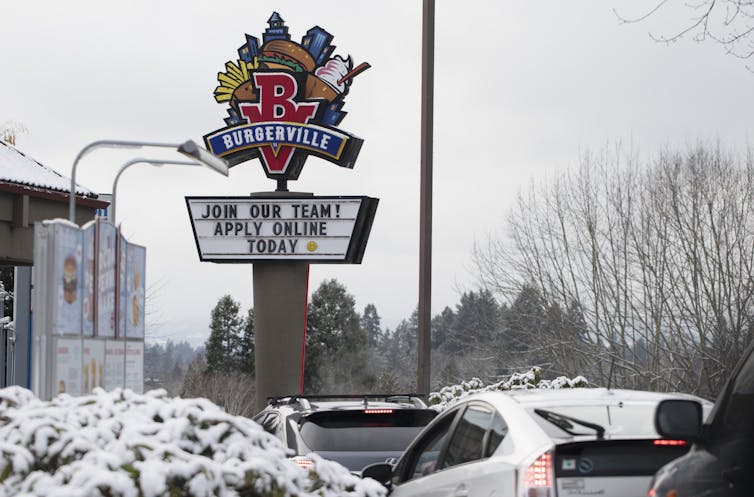
Christopher Decker, University of Nebraska Omaha
The first U.S. jobs report of 2022 showed continued - if lackluster - growth. But perhaps of greater significance for the economic year ahead are two factors that lurked behind the headline unemployment rate: a stagnating labor pool and the impact of omicron.
First, the good news. The economy did add jobs in December, 199,000 of them, with gains in most sectors. This was less than the 440,000-job increase that some economists expected. Still, the gains are an indication of a reasonably healthy economy.
And October and November jobs numbers were revised upward by the Bureau of Labor Statistics. Meanwhile, gains were seen across a number of key sectors. The leisure and hospitality sector was up, as expected given recent trends, as were business services and manufacturing.
Construction was also up and should continue to gain in the months to come - if it can find the workers.
The stagnating labor market
The unemployment rate was down to 3.9% - a new low in the pandemic era. This is good, to a degree. People who want jobs are finding them.
The problem is employers are having a hard time finding the workers amid a somewhat stagnating labor market.
The number of people in the labor force increased a little in December, but not by much - only about 168,000. And with job openings outpacing this small increase in the labor market, there remains a significant risk that worker wages may begin to rise too quickly for the economy.
While this is great for workers, it poses a concern for those trying to tamp down the rising prices of goods. Higher wages in the hands of workers means more money to spend, which generally drives prices of goods upward.
The latest report shows that wages are up, hours worked remain constant and the participation rate was unchanged. Even the number of people not in the labor force but wanting a job changed little. It is very much a sellers market in labor right now. Strikes, wage pressure and more flexible work environments may become the new normal.
Separate data from November, released on Jan. 4, 2021, by the Bureau of Labor Statistics, provides further evidence of a drying up labor market. There were 6.9 million hires that month but 10.6 million job openings - a clear imbalance. Meanwhile the share of workers voluntarily quitting their jobs continued to be high.
It appears that many Americans who lost their jobs in 2020 have either taken early retirement or are still delaying re-entering the workforce.
And those hesitating to rush back to the office or factory floor are unlikely to be encouraged by the problem not yet reflected in jobs data: omicron.
The slowdown to come
The latest jobs report does not really reflect the effect of omicron on the labor market. The monthly jobs data is typically collected mid-month - before the highly contagious COVID-19 variant really took hold in the U.S.
[Over 140,000 readers rely on The Conversation's newsletters to understand the world. Sign up today.]
But if the U.S. doesn't see omicron cases peaking soon, Americans will likely see some real slowdown in hiring. With more workers falling ill and unable to work, managers at retail stores, as well as bars and restaurants, may well be forced to reduce hours of operation, reducing revenue and slowing growth in the process.
We are already seeing this with airlines, which have been forced to cancel flights. The real sectors at risk here are the leisure and hospitality sectors and retail - two industries that have bounced back quite well of late.
This may all sound a little downbeat given that the December jobs report did show gains. Growth is growth - it is just that the risks to the economy are quite high right now.![]()
Christopher Decker, Professor of Economics, University of Nebraska Omaha
This article is republished from The Conversation under a Creative Commons license. Read the original article.
For the 5 Most Fascinating Stories in Franchising, a weekly report, click here & sign up.




















Gary Kennett The unfortunate part of being a Franchisee, as I have experienced and observed is, that the Franchisor makes decisions, about Advertising, Sales Promotions, New Product ideas, and certainly, Operational Procedures, that directly affect your bottom line. They may have no clue about your immediate Market potential, but whatever they say, goes, as they move forward with their plans for sales promotions (i.e. DISCOUNTS), and product launches, that may have very little impact on your business, other than, discounting your Profit Margin. At the end of the day, if they're making 7.5% or more of your Gross Sales then, that's what they seem to care about. If they were tied into your Profit Margin then, they may pay closer attention as to who and how they effect their Franchisees. One might say "Well, wouldn't they be concerned if you potentially, went out of business, due to their blind shotgun strategies?" My answer is "No", they would simply approach you with a rock bottom "buy out" price, because your business was no longer worth what it could be, and move on. It's a sad day in Franchising, if you ask me.
Jim RuckerHaving worked as both a Franchisee and for a Franchisor, an important issue I see is Franchisees entering into a franchise system with the unrealistic expectation of owning their own business and operating it as they see fit. Yes, they own a business but really what was purchased was the Franchisor's system and if the system is not followed, it can ruin a brand. While many new Franchisees appreciate the system when they start, they can become resentful later because they are not given the leeway to operate things their way. Branding is perhaps the most compelling reason to buy into a franchise system and in order to maintain a high level of consistency and meet customer expectations, there must be compliance with the system. Most franchisees are not born business experts and struggle with some of the most important aspects of successful business operations. Again, they appreciate the system while they are learning it but once it is mostly mastered, dissatisfaction can creep in with the control the Franchisor maintains. One other thing I see concerning Franchisee dissatisfaction is everyone would operate differently if they were the Franchisor and regardless of the decisions made, you aren't going to please everyone. Decisions made by the Franchisor must be made in the best interest of the Franchisor and the system as a whole.
Madam Becky AdamsI have found this dissatisfaction when interviewing franchisees, and it seems to start after a year or so when they feel they are no longer getting value for money in the form of training and support.
If you're trying to do right by the franchise partner it must be soul destroying for a franchisor to be complained about all the time!
Gary KennettFor me, I was very well aware of the relationship, between Franchisor and Franchisee, but the difference is that I thought the Franchisee had more collective influence, as a Group, and the overall situation and status of different events, has proven that we don't. So, I certainly, was not under the belief that I would come into the picture and change my product menu, to offer things the Franchisor doesn't, but I would summarily say that "most of us are not pleased with their dictatorial approach to various issues.
Tim EvansLike Paul said, a lot of franchisees come into the business after being "outsourced" or "downsized" with no previous business experience. They are generally unemployable (not really) to most companies based on age, etc. The franchise system offers them an opportunity to come in a business system, which offers them the core structure of running a business. Unfortunately, all they have is a JOB (just over broke). The key is to make as much as you can above the line (yes the franchise gets their share), but manage your below the line expenses to maximize "your money".
Robert RicheRobert Riche. I was a franchisee for over 20 years running multiple units, and almost five years in a senior corporate position. Purchasing a franchise is a very dangerous proposition. All the power and control rest with the franchisor, you end up with a lot of turn over of management staff, field management etc., most systems have a high turnover every 3 to 5 years, everyone thinks they have a better idea. Tim your comment about franchisee's is true, but that's what the industry attracts. You can list the quality operations on one hand. Everything else is suspect.
Gary KennettMy situation was different than most, in that, the original franchising co. was bought out, but by folks not well experienced in the business. Then, they began implementing their view of the business, and it's future complexion and business model, along with the new "culture" and "atmosphere" they wanted to convey. Due to the very nature of the original business, and how it was now, differing with the newer ideas being brought in, it simply clashed and I think alot of conflict resulted.
Madam Becky Adams
Thank you so much guys for your thoughts. I have been considering trying to combine a franchise structure with a business mentoring model...
So, for example, with the gardening and grounds business, instead of someone buying a franchise, they buy a 'business in a box'.
Their brand, their business to do what they want with.
They buy a step by step proven model, training and support, but the business is theirs from the outset. If after a year of help from a team of on-site and on-line experts they feel they have enough experience, they can cut loose and go it alone, or just buy the support services they think they need.
To me, from having spoken to so many miserable franchisees, it gives the best of both worlds. Autonomy within a proven structure and as much support as you do or don't feel you need.
Cláudio PazinI am franchisee here in Brazil and the brand that I represent is recognized and has several awards, but the results and expectations presented by the franchisor during the sale process weren't reliable. For example... units with a bad results are often offered to Franchisor Managers or older franchisees at very low prices. It's a way to avoid to show the "shut down" number. There was two years ago I searched for another brand in a different segment, but analyzing the franchisor's data I realized that the data provided weren't also reliable, so I faced the franchisor with my analysis and I heard the answer that if the franchisor tells the truth would be impossible to sell franchises. Of course that time I gave up...
Carlos RocheHello Claudio, Sorry to hear about your situation. I understand that the franchisor may have lied about the real numbers, however, if the franchise is solid, give it all you've got and sell.
Do you still have the franchise?
What kind of product or service do you provide?
For the 5 Most Fascinating Stories in Franchising, a weekly report, click here & sign up.
To Comment Original LinkedIn Discussion here -- Click here
To Comment on this Article --Click here